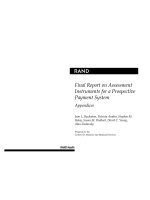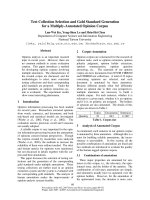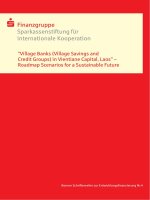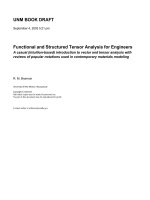Tutorial Final and Construction Stage Analysis for a Cable-Stayed Bridge potx
Bạn đang xem bản rút gọn của tài liệu. Xem và tải ngay bản đầy đủ của tài liệu tại đây (6.53 MB, 68 trang )
Tutorial
Final and Construction Stage Analysis for
a Cable-Stayed Bridge
C
C
C
i
i
i
v
v
v
i
i
i
l
l
l
CONTENTS
Summary 1
Bridge Dimensions ···································································································2
Loading ·····················································································································2
Working Condition Setting······················································································· 3
Definition of Material and Section Properties ····························································4
Final Stage Analysis 6
Bridge Modeling ········································································································7
2D Model Generation ································································································8
Girder Modeling·········································································································9
Tower Modeling·······································································································10
3D Model Generation ······························································································13
Main Girder Cross Beam Generation ······································································15
Tower Cross Beam Generation ··············································································· 17
Tower Bearing Generation ······················································································19
End Bearing Generation··························································································22
Boundary Condition Input························································································24
Cable Initial Prestress Calculation···········································································27
Loading Condition Input ··························································································28
Loading Input ··········································································································29
Perform Structural Analysis·····················································································33
Final Stage Analysis Results Review 33
Load Combination Generation ················································································33
Unknown Load Factors Calculation·········································································34
Deformed Shape Review ························································································38
Construction Stage Analysis 39
Construction Stage Category ··················································································40
Cannibalization Stage Category··············································································41
Backward Construction Stage Analysis···································································42
Input Cable Initial Prestress ····················································································44
Define Construction Stage ······················································································48
Assign Structure Group ···························································································49
Assign Boundary Group ·························································································· 52
Assign Load Group··································································································55
Assign Construction Stage ······················································································58
Input Construction Stage Analysis Data ··································································59
Perform Structural Analysis·····················································································59
Review Construction Stage Analysis Results 60
Review Deformed Shapes·······················································································60
Review Bending Moments·······················································································61
Review Axial Forces································································································ 62
Construction Stage Analysis Graphs ······································································63
FINAL AND CONSTRUCTION STAGE ANALYSIS FOR CABLE-STAYED BRIDGES
1
Summary
Cable-stayed bridges are structural systems effectively composing cables, main girders and
towers. This bridge form has a beautiful appearance and easily fits in with the surrounding
environment due to the fact that various structural systems can be created by changing the
tower shapes and cable arrangements.
Cable-stayed bridges are structures that require a high degree of technology for both design and
construction, and hence demand sophisticated structural analysis and design techniques when
compared with other types of conventional bridges.
In addition to static analysis for dead and live loads, a dynamic analysis must also be
performed to determine eigenvalues. Also moving load, earthquake load and wind load
analyses are essentially required for designing a cable-stayed bridge.
To determine the cable prestress forces that are introduced at the time of cable installation, the
initial equilibrium state for dead load at the final stage must be determined first. Then,
construction stage analysis according to the construction sequence is performed.
This tutorial explains techniques for modeling a cable-stayed bridge, calculating initial cable
prestress forces, performing construction stage analysis and reviewing the output data. The
model used in this tutorial is a three span continuous cable-stayed bridge composed of a 220 m
center span and 100 m side spans. Fig. 1 below shows the bridge layout.
Fig. 1 Cable-stayed bridge analytical model
F
INAL
AND
C
ONSTRUCTION
S
TAGE
A
NALYSIS
FOR
C
ABLE
-S
TAYED
B
RIDGES
2
Bridge Dimensions
The bridge model used in this tutorial is simplified because its purpose is to explain the analytical
sequences, and so its dimensions may differ from those of a real structure.
The dimensions and loadings for the three span continuous cable-stayed bridge are as follows:
Bridge type Three span continuous cable-stayed bridge (self-anchored)
Bridge length L = 100 m+220 m+100 m = 420 m
Bridge Width B = 15.6 m (2 lanes)
Lanes 2 lane structure
Fig. 2 General layout
Loading
Self-weight: Automatically calculated within the program
Additional dead load: pavement, railing and parapets
Initial cable prestress forces: Cable prestress forces that satisfy
initial equilibrium state at the final stage
Fig. 3 Tower layout
2@3 + 8@10 + 14 = m 14 + 8@10 + 2@3 = m14 + 9@10 + 12 + 9@10 + 14 = m
m
m m
m
We input
initial cable
prestress force
values, which
can be calculated
by built-in
optimization
technique in
MIDAS/Civil.
F
INAL
AND
C
ONSTRUCTION
S
TAGE
A
NALYSIS
FOR
C
ABLE
-S
TAYED
B
RIDGES
3
Working Condition Setting
To perform the final stage analysis for the cable-stayed bridge, open a new file and save it as ‘cable
stayed’, and start modeling. Assign ‘m’ for length unit and ‘kN’ for force unit. This unit system
can be changed any time during the modeling process for user’s convenience.
File /
New Project
File /
Save (cable stayed)
Tools / Unit System
Length>
m
; Force (Mass)>
kN (ton)
↵
Fig. 4 Assign Working Condition and Unit System
F
INAL
AND
C
ONSTRUCTION
S
TAGE
A
NALYSIS
FOR
C
ABLE
-S
TAYED
B
RIDGES
4
Definition of Material and Section Properties
Input material properties for the cables, main girders, towers, cross beams between the main girders
and tower cross beams. Click
button under Material tab in Properties dialog box.
Model / Properties /
Material
Name (Cable); Type>User Defined
Analysis Data>Modulus of Elasticity (1.9613e8); Poisson’s Ratio (0.3)
Weight Density (77.09)
↵
Input material properties for the main girders, towers (pylons), cross beams between the main
girders and tower cross beams similarly. The input values are shown in Table 1.
Table 1 Material Properties
ID Component
Modulus of Elasticity
(kN/m
2
)
Poisson’s Ratio
Weight Density
(kN/m
3
)
1 Cable 1.9613
×
10
8
0.3 77.09
2 Girder 1.9995×10
8
0.3 77.09
3 Pylon 2.78×10
7
0.2 23.56
4 CBeam_Girder 1.9613×10
8
0.3 77.09
5 CBeam_Pylon 2.78×10
7
0.2 23.56
Fig. 5 Defined Material Properties
F
INAL
AND
C
ONSTRUCTION
S
TAGE
A
NALYSIS
FOR
C
ABLE
-S
TAYED
B
RIDGES
5
Input section properties for the cables, main girders, towers (pylons), cross beams between the main
girders and tower cross beams. Click
button under Section tab in Properties dialog box.
Model / Properties /
Section
Value tab
Section ID (1); Name (Cable)
Section Shape>
Solid Rectangle;
Stiffness>Area
(0.0052) ↵
Input section properties for the main girders, towers (pylons), cross beams between the main girders
and tower cross beams similarly. The values are shown in Table 2.
Table 2 Section Properties
ID Component
Area
(m
2
)
Ixx
(m
4
)
Iyy
(m
4
)
Izz
(m
4
)
1 Cable 0.0052 0.0 0.0 0.0
2 Girder 0.3902 0.007 0.1577 4.7620
3 Pylon 9.2000 19.51 25.5670 8.1230
4 CBeam_Girder 0.0499 0.0031 0.0447 0.1331
5 CBeam_Pylon 7.2000 15.79 14.4720 7.9920
Fig. 6 Defined Section Properties
F
INAL
AND
C
ONSTRUCTION
S
TAGE
A
NALYSIS
FOR
C
ABLE
-S
TAYED
B
RIDGES
6
Final Stage Analysis
After completion of the final stage modeling for the cable-stayed bridge, we calculate the cable
initial prestress forces for self-weights and additional dead loads. After that, we perform initial
equilibrium state analysis with the calculated initial prestress forces.
To perform structural modeling of the cable-stayed bridge, we first generate a 2D model by Cable
Stayed Bridge Wizard provided in MIDAS/Civil. We then copy the 2D model symmetrically to
generate a 3D model. Initial cable forces introduced in the final stage can easily be calculated by the
Unknown Load Factors function, which is based on an optimization technique. The final model of
the cable-stayed bridge is shown in Fig. 7.
Fig. 7 Final Model for Cable-Stayed Bridge
F
INAL
AND
C
ONSTRUCTION
S
TAGE
A
NALYSIS
FOR
C
ABLE
-S
TAYED
B
RIDGES
7
Bridge Modeling
In this tutorial, the analytical model for the final stage analysis will be completed first and
subsequently analyzed. The final stage model will then be saved under a different name, and then
using this model the construction stage model will be developed.
Modeling process for the final stage analysis of the cable-stayed bridge is as follows:
1. 2D Model Generation by Cable-Stayed Bridge Wizard
2. Tower Modeling
3. Expand into a 3D Model
4. Main Girder Cross Beam Generation
5. Tower Bearing Generation
6. End Bearing Generation
7. Boundary Condition Input
8. Initial cable Prestress Force Calculation by Unknown Load Factors
9. Loading Condition and Loading Input
10. Perform Structural Analysis
11. Unknown Load Factors Calculation
F
INAL
AND
C
ONSTRUCTION
S
TAGE
A
NALYSIS
FOR
C
ABLE
-S
TAYED
B
RIDGES
8
2D Model Generation
MIDAS/Civil provides a Cable-Stayed Bridge Wizard function that can automatically generate a
2D cable-stayed bridge model based on basic structural dimensions of the bridge. Input basic
structural dimensions of the cable-stayed bridge in the Cable-Stayed Bridge Wizard as follows.
Front View Point Grid (off) Point Grid Snap (off)
Line Grid Snap (off) Node Snap (on) Elements Snap
(on)
Model / Structure Wizard /
Cable Stayed Bridge
Type>Symmetric Bridge
A>X (m) (0) ; Z (m) (25) ; B>X (m) (100) ; Z (m) (90)
Height>H1 (m)
(90)
Material>Cable>1:Cable ; Deck>2:Girder ; Tower>3:Pylon
Section>Cable>1:Cable
; Deck>2:Girder
; Tower>3:Pylon
Select Cable & Hanger Element Type>Truss
Shape of Deck (on)>Left Slope (%) (5) ; Arc Length (m) (220)
Cable Distances & Heights
Left>Distance (m) (3, 8@10, 14) ; Height (m) (1.2, , 3@2, , 45)
Center>Distance (m) (14, 9@10, 12, 9@10, 14) ↵
Fig. 8 Cable-Stayed Bridge Wizard Dialog Box
Using the Cable
Stayed Bridge
Wizard function, a 2D
model can be
generated
automatically based
on material and
section properties of
the cables, main
girders and towers.
If Truss is
selected as the
element type for
cables, truss
elements are
generated; and if
Cable is selected, it
will automatically
generate equivalent
truss elements for
linear analysis and
elastic catenary
cable elements for
n
o
nlin
ea
r
a
n
a
l
ys
i
s
.
Input vertical
slopes as 5% for both
side spans, and use
a circular curve for
the center span,
which is continuous
from each side span.
If Drawing in View
option is selected, the
2D model shape, which
will be generated based
on the input dimensions,
can be viewed in the
wizard window.
F
INAL
AND
C
ONSTRUCTION
S
TAGE
A
NALYSIS
FOR
C
ABLE
-S
TAYED
B
RIDGES
9
Girder Modeling
Duplicated nodes will be generated at the tower locations since the Cable-Stayed Bridge Wizard
will generate the main girders as a simple beam type for the side and center spans. This tutorial
example is a continuous self-anchored cable-stayed bridge. We will use the Merge Node function to
make the girders continuous at the tower locations.
Node Number (on) Front View
Model / Nodes /
Merge Nodes
Merge>All
Tolerance (0.001)
Remove Merged Nodes (on) ↵
Fig. 9 Generated 2D Model of the Cable-Stayed Bridge
F
INAL
AND
C
ONSTRUCTION
S
TAGE
A
NALYSIS
FOR
C
ABLE
-S
TAYED
B
RIDGES
10
Tower Modeling
The upper and lower widths of the towers are 15.600 m and 19.600 m respectively. To model the
inclined towers, the lower parts of the towers will be moved 2m in the –Y direction using the
Translate Node function.
Left View
Auto Fitting
Node Number
(off)
Model / Nodes /
Translate Nodes
Select Window (Nodes: A in Fig. 10)
Mode>Move; Translation>Equal Distance; dx, dy, dz ( 0, -2, 0 ) ↵
Fig. 10 Arrangement of Inclined Towers
Before Execution
A
F
INAL
AND
C
ONSTRUCTION
S
TAGE
A
NALYSIS
FOR
C
ABLE
-S
TAYED
B
RIDGES
11
The local coordinate system of the inclined tower elements is changed with the movement of the
nodes. This is because the Beta Angle is changed according to the placement direction of each
element.
For the easy review of analysis results, we will make the local element coordinate
systems of the upper and lower tower elements coincide by changing the Beta Angle of the tower
elements to -90°.
Display
Element>Local Axis(on) ↵
Model / Elements /
Change Element Parameters
Select Intersect (Elements: A in Fig. 11)
Parameter Type>Beta Angle
Beta Angel (Deg)
(-90) ↵
Fig. 11 Local Element Axis Transformation for Tower Elements
Detailed
explanations for Beta
Angle can be found
in “Tutorial for 3D
Simple 2-Bay Frame”
or “Truss Element”
parts in “Types of
Elements and
Important
Considerations” in
“Analysis for Civil
Structures”.
Before Execution
A
F
INAL
AND
C
ONSTRUCTION
S
TAGE
A
NALYSIS
FOR
C
ABLE
-S
TAYED
B
RIDGES
12
To generate the tower cross beams, divide the tower elements in the Z-axis direction by Divide
Elements.
Model / Elements /
Divide Elements
Select Previous
Divide>Element type>
Frame
;
Unequal Distance
x (m) (10, 36)
↵
Fig. 12 Division of Tower Elements
36.0 m
10.0 m
F
INAL
AND
C
ONSTRUCTION
S
TAGE
A
NALYSIS
FOR
C
ABLE
-S
TAYED
B
RIDGES
13
3D Model Generation
To generate the 3D model, we move the 2D model –7.800m in the Y direction, as the bridge width
is 15.600 m.
Model / Nodes /
Translate Nodes
Select All
Mode>Move; Translation>Equal Distance; dx, dy, dz ( 0, -7.8, 0 )
↵
Fig. 13 Moving 2D Model –7.800m to the Y direction
7.8 m
F
INAL
AND
C
ONSTRUCTION
S
TAGE
A
NALYSIS
FOR
C
ABLE
-S
TAYED
B
RIDGES
14
We now copy the cables, main girders and towers symmetrically with respect to the centerline of
the bridge. At this time, we will check on Mirror Element Angle to match the local coordinates of
the copied towers to those of the origin towers.
Model / Elements /
Mirror Elements
Select All
Mode>Copy
Reflection>z-x plane (m) ( 0 )
Mirror Beta Angel (on) ↵
Fig. 14 Generating 3D Model
Reflection Plane
F
INAL
AND
C
ONSTRUCTION
S
TAGE
A
NALYSIS
FOR
C
ABLE
-S
TAYED
B
RIDGES
15
Main Girder Cross Beam Generation
Clear Display for the element coordinate axes and then generate the crossbeams between the main
girders by the Extrude Element function, which creates line elements from nodes.
Top View
Display
Element> Local Axis (off) ↵
Model / Elements /
Extrude Elements
Select Identity - Nodes
Select Type>Material>2: Girder ; Nodes (on), Elements (on)
↵
Unselect window (Nodes: A in Fig. 15)
Extrude Type>
Node
→
Line Element
Element Attribute>Element Type>Beam
Material>4: CBeam_Girder
Section>4: CBeam_Girder
Generation Type>Translate
Translation>
Equal Distance
; dx, dy, dz
(0, -15.6, 0)
Number of Times (1) ↵
F
INAL
AND
C
ONSTRUCTION
S
TAGE
A
NALYSIS
FOR
C
ABLE
-S
TAYED
B
RIDGES
16
Fig. 15 Main Girder Cross Beam Generation
A
F
INAL
AND
C
ONSTRUCTION
S
TAGE
A
NALYSIS
FOR
C
ABLE
-S
TAYED
B
RIDGES
17
Tower Cross Beam Generation
Before generating the tower cross beams, we activate only the tower elements for effective
modeling.
Front View
Select Single (A in Fig. 16)
Active
Fig. 16 Selecting Tower Elements
A A
F
INAL
AND
C
ONSTRUCTION
S
TAGE
A
NALYSIS
FOR
C
ABLE
-S
TAYED
B
RIDGES
18
Generate the tower cross beams by the Create Element function.
Iso View Node Number (on) Element Snap (off)
Model / Elements /
Create Elements
Element type>General Beam/Tapered Beam
Material>5: CBeam_Pylon
Section>5: CBeam_Pylon
Nodal Connectivity
(142, 72) (145, 73) (144, 74) (147, 75)
Fig. 17 Tower Cross Beam Generation
F
INAL
AND
C
ONSTRUCTION
S
TAGE
A
NALYSIS
FOR
C
ABLE
-S
TAYED
B
RIDGES
19
Tower Bearing Generation
Create new nodes at the tower bearing locations by the Project Nodes function.
Model / Nodes /
Project Nodes
Mode>Copy; Projection Type>Project nodes on a plane
Select Single (Nodes:
34, 137, 57, 139
)
Base Plane Definition>P1 (145)
;P2 (73)
; P3 (75)
; Direction>Normal
Merge Duplicate Nodes (on); Intersect Frame Elem. (on) ↵
Fig. 18 Tower Bearing Generation
F
INAL
AND
C
ONSTRUCTION
S
TAGE
A
NALYSIS
FOR
C
ABLE
-S
TAYED
B
RIDGES
20
Generate nodes at the tower bearing locations using the Translate Nodes function to reflect the
bearing heights.
Model / Nodes /
Translate Nodes
Select Single (Nodes: 149 to 152)
Mode>
Copy
; Translation>
Equal Distance
dx, dy, dz ( 0, 0, 0.27)
↵
Fig. 19 Tower Bearing Location Generation
F
INAL
AND
C
ONSTRUCTION
S
TAGE
A
NALYSIS
FOR
C
ABLE
-S
TAYED
B
RIDGES
21
Model the tower bearings using the element link elements.
Bearing properties are as follows:
SDx: 199,736,032 kN/m
SDy: 73,373 kN/m
SDz: 73,373 kN/m
Model / Boundaries / Elastic Link
Zoom Window (A in Fig. 20)
Options>Add/Replace; Link Type>General Type
SDx (kN/m) (199736032); SDy (kN/m) (73373); SDz (kN/m) (73373)
Copy Elastic Link
(on)>Axis>
x;
Distances (m)
(220)
2 Nodes (151,155)
2 Nodes (149,153)
Fig. 20 Tower Bearing Generation
Simultaneously
input elastic link
elements for both
towers by entering
tower spacing of
220 m.
A
F
INAL
AND
C
ONSTRUCTION
S
TAGE
A
NALYSIS
FOR
C
ABLE
-S
TAYED
B
RIDGES
22
End Bearing Generation
Generate nodes at the end bearing locations using the Translate Nodes function.
Active All
Model / Nodes /
Translate Nodes
Select Single (Nodes: 76, 24, 135, 68)
Mode>
Copy
; Translation>
Unequal Distance
Axis>z; Distance (m) (-4.5, -0.27) ↵
Fig. 21 Generating Nodes at the End Bearing Locations









